Refined deodorized sunflower oil · PET bottled
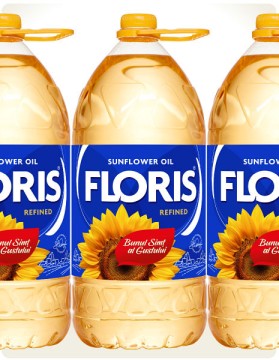
- 1 Ltr bottle (1-liter bottle) · in carton box of 15 bottles
- 3 Ltr bottle (3-liter bottle) · in carton box of 4 bottles
- 5 Ltr bottle (5-liter bottle) · in carton box of 3 bottles
This pale-yellow colored oil, extracted from sunflower seeds, is a high qualitative oil which has an extended storage period. Sunflower oil is light in taste and appearance and supplies more Vitamin E than any other vegetable oil. It is a combination of monounsaturated and polyunsaturated fats with a low saturated fat levels.
Sunflower oil-products with really amazing properties.
Refined deodorized sunflower oil is a natural sunflower oil is produced according to the modern multi-stage technology and it is purified from all impurities. It stimulates metabolic processes in the body, ensures proper cell growth and healthy skin. This oil can be used with any dishes and it is suitable for all types of food processing: frying, baking, canning, making salads. It is a high-tech raw material for the food industry (fat-and-oil products, dairy and bakery industry)
| Physical properties | |
|---|---|
| Appearance | No residue at 40°C |
| Cold test | Min. 48 hours at 0°C |
| Color value iodine | Max. 2.5 mgI |
| Refractive index | 1.461–1.468 at 40°C |
| Density | 0.918–0.923 g/cm³ at 20°C |
| Volatile matter | Max. 0.1% at 105°C |
| Taste | Excellent |
| Odor | None – not sensed |
| Chemical specifications | |
|---|---|
| Free fatty acids (FFA) | Max 0.1 |
| Saponification value | 190 mg KOH / g of oil |
| Iodine value | 125–145 g I₂ / 100 g |
| Peroxide | 0.2 mmol O₂ / kg of oil |
| Soap | None |
| Unsaponifiable matter | Max 1.2% |
| Impurities | None |
| Saturated fatty acids | 8–12% |
| Unsaturated fatty acids | 87–91% |
| Feeding energy | 900 kcal |
| Fatty acid composition | |
|---|---|
| Myristic acid C14:0 | 0.07 |
| Palmitic acid C16:0 | 7.00 |
| Stearic acid C18:0 | 3.50 |
| Oleic acid (octadecenoic acid), C18:1 (omega 9) | 27.2 |
| Linoleic acid (octadecadienoic acid), C18:2 (omega 6) | 61.4 |
| Gamma-linolenic acid (octadecatrienoic), C18:3 (omega 6) | <0.1 |
| Alpha-linolenic acid (octadecatrienoic), C18:3 (omega 3) | <0.1 |
| Arachidic acid C20:0 | 0.2 |
Refined deodorized sunflower oil · in bulk
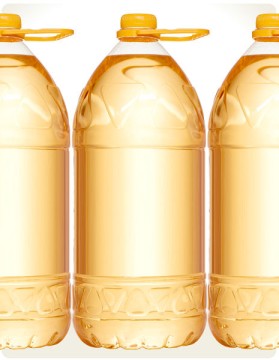
The area of use of refined deodorized oil is very large.
This oil is used both in household cooking and in production. Due to the fact that refined oil does not have its own taste and smell it is widely used for cooking any dishes. It is especially appreciated for the production of semi-finished products, canned food, all kinds of dough on an industrial scale. Very widely this oil is used in deep frying, in the production of margarine, cooking fats, cheese products. Only deodorized refined sunflower oil is allowed for the manufacture of dietary products and baby food. Also, this purified oil is used in the production of cosmetic and pharmaceutical products. A huge number of creams and ointments are made on the basis of refined oil.
| Physical properties | |
|---|---|
| Appearance | No residue at 40°C |
| Cold test | Min. 48 hours at 0°C |
| Color value iodine | Max. 2.5 mgI |
| Refractive index | 1.461–1.468 at 40°C |
| Density | 0.918–0.923 g/cm³ at 20°C |
| Volatile matter | Max. 0.1% at 105°C |
| Taste | Excellent |
| Odor | None – not sensed |
| Chemical specifications | |
|---|---|
| Free fatty acids (FFA) | Max. 0.1 |
| Saponification value | 190 mg KOH/g of oil |
| Iodine value | 125–145 g I₂/100g |
| Peroxide | 0.2 mmol O₂/kg of oil |
| Soap | None |
| Unsaponifiable matter | Max. 1.2% |
| Impurities | None |
| Saturated fatty acids | 8–12% |
| Unsaturated fatty acids | 87–91% |
| Feeding energy | 900 kcal |
| Fatty acid composition | |
|---|---|
| Myristic acid C14:0 | 0.07 |
| Palmitic acid C16:0 | 7.00 |
| Stearic acid C18:0 | 3.50 |
| Oleic acid (octadecenoic), C18:1 (omega 9) | 27.2 |
| Linoleic acid (octadecadienoic), C18:2 (omega 6) | 61.4 |
| Gamma-linolenic acid (octadecatrienoic), C18:3 (omega 6) | <0.1 |
| Alpha-linolenic acid (octadecatrienoic), C18:3 (omega 3) | <0.1 |
| Arachidic acid C20:0 | 0.2 |
Сrude sunflower oil · in bulk
Sunflower oil, which is further used for refining.
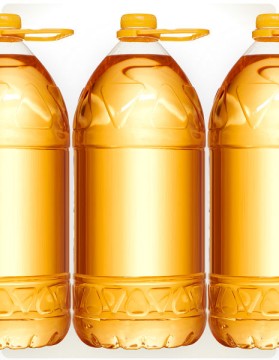
| Physical and chemical characteristics | |
|---|---|
| Odour, taste | Specific for this product |
| Refractive index (40ºC) | 1,461 – 1,468 |
| Specific gravity (20ºC) | 0,918 - 0,923 |
| Moisture and volatile substances | 0,2% |
| Free fatty acid (As Oleic Acid) | 1,5% |
| Insoluble impurities | 0,1% |
| Jodine value | 125-145 gJ₂/100g |
| Saponification value | 188-194 mg KOH/g |
| Unsaponification matters | Max. 1,5 |
| Composition in fatty acids | |
|---|---|
| Myristic acid (C14:0) | < 0,2% |
| Palmitic acid (C16:0) | 5,0–7,6% |
| Stearic acid (C18:0) | 2,7–6,5% |
| Oleic acid (C18:1) | 14,0–39,4% |
| Linoleic acid (C18:2) | 48,3–74,0% |
| Arachidic acid (C20:0) | 0,1–0,5% |
| Behenic acid (C22:0) | 0,3–1,5% |
Sunflower meal · in bulk
Sunflower meal is presented as a by-product of the production of sunflower oil. The raw materials are ordinary sunflower seeds.
Sunflower meal is a fairly valuable product, widely used in agriculture, for feeding birds and animals. Sunflower meal contains in its composition phosphorus, vitamins B and E and other mineral substances, therefore it is so indispensable as an additive in the animal feed.
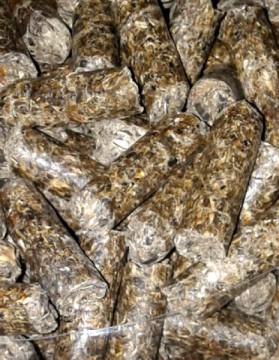
| General specifications of sunflower meal | |
|---|---|
| Moisture and volatile matter content | 8–11% |
| Crude protein (on dry matter) | Min 37% |
| Crude fiber | Max 19% |
| Crude fat | Max 1,5% |
- General energy nutrient value – not less than 0,968 feed units.
- Storage period: 3 months from manufacturing date
- Packing/ tare: in bulk
- Storage requirements: to be stored in clean, dry, well-ventilated warehouses or warehouses with supply-and-exhaust ventilation, protected from direct sunlight, heat and humidity, and pest controlled.
The goods undergo strict quality assurance control. Sunflower meal is certificated and it meets International Standards. It is supported by veterinary certificate and certificate of quality
Sunflower husk pellets · in bulk
Recently, the fuel made from sunflower waste has gained considerable popularity. Thus, from sunflower husk produce granulated fuel granules – the рellets made from sunflower husks that have several advantages:
- Environmentally friendly - in their composition there are no chemicals, spores of plants, seeds, causing allergic reactions.
- Cost-effective - the cost of pellets is low, especially in the regions where the sunflower grow.
- Functionality - granules can be stored for a long time, since their biochemical activity is low. These have a relatively low price, with no seasonal increases. According to consumers, this is a valuable advantage of this type of fuel.
- The lack of special storage conditions that do not require additional space. This is due to the fact that the granules have a high bulk density.
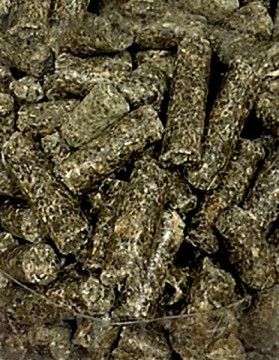
| Characteristics of granulated husk | |
|---|---|
| Appearance | Granules with diameter from 8 to 10 mm, length from 15 to 50 mm |
| Color | Gray, various shades |
| Odour | Peculiar to sunflower husk odor |
| Moisture and volatile matter | 9–12% |
| Bulk density | 500–550 kg/m³ |
The pellets heat the furnace at home and they go to kindling boilers in industrial production.
When this fuel is burned, negligible amount of carbon dioxide is emitted, by volume it is comparable with to carbon dioxide from burning wood. In addition, the remaining ash can also be used to fertilize plants.
Sunflower husk briquettes · in bulk / in shrink film
The briquettes are part of a range of renewable fuel emission of CO2 neutral. This should be more effective alternative compared to wood, they are easy to use. Combustion period is increased compared with wood, charcoal or coke, due to the high calorific power of 4889 kcal/kg, it does not impart odor or sparks, and storage is low. They compact package available in any quantity. Used multiplied: stoves, central heating, fireplaces, wood boilers.
Does not contain dyes, additives and it is readily ignite. No need cutting and growth. Briquettes do not need care, maximum humidity is 12.0% - equivalent to a dry wood for over two years. The ash from the combustion of 3.0% max can be used as a natural fertilizer.
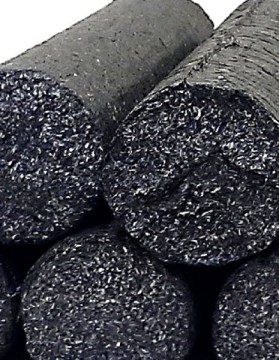
| Characteristics of husk briquettes | |
|---|---|
| Appearance | Granules with diameter from 80 to 90 mm, length from 200 to 500 mm |
| Color | Gray, various shades |
| Odour | Peculiar to sunflower husk odor |
| Moisture and volatile matter | 9–12% |
| Bulk density | 1000–1200 kg/m³ |
Fatty acids, non-distilled · in bulk
Fatty acids are obtained from fat waste from the production of vegetable oils intended for use in soap making and for other purposes.
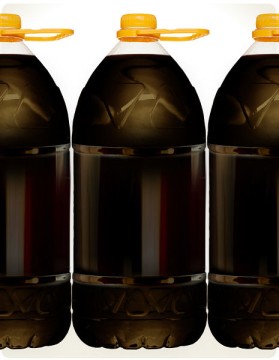
| Characteristics of fatty acids | |
|---|---|
| Color (20°C) | Dark brown |
| Smell | Specific for fatty acids |
| Moisture and volatile matter | Max 5% |
| Mass fraction of impurities insoluble in diethyl ether | Max 5% |
| Total fat | 90–95% |
| Presence of sulfuric acid | Absence |
